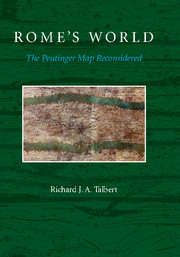Book contents
- Frontmatter
- Contents
- List of Plates, Figures, and Table
- Preface and Acknowledgments
- Abbreviations
- INTRODUCTION
- 1 THE SURVIVING COPY: HISTORY, PUBLICATION, SCHOLARSHIP
- 2 THE SURVIVING COPY: THE MATERIAL OBJECT AND ITS PALEOGRAPHY
- 3 THE DESIGN AND CHARACTER OF THE MAP
- 4 RECOVERY OF THE ORIGINAL MAP FROM THE SURVIVING COPY
- 5 THE ORIGINAL MAP
- CONCLUSION: THE MAP'S PLACE IN CLASSICAL AND MEDIEVAL CARTOGRAPHY
- APPENDIX 1 Latin Text Appended to the 1598 Engraving of the Map
- APPENDIX 2 English Translation of J. Kastelic, “Vodnikova kopija Tabule Peutingeriane” (trans. Gerald Stone)
- APPENDIX 3 Reflections on Vodnik's Copy of von Scheyb's Engraving
- APPENDIX 4 Vodnik's Latin Summary of Heyrenbach's Essay (National Library of Slovenia, Ljubljana, MS 1443)
- APPENDIX 5 Miller's Reconstruction of the Map's Western End
- APPENDIX 6 Wyttenbach's Claim: A Lost Piece of the Map Discovered
- APPENDIX 7 User's Guide to the Database and Commentary
- APPENDIX 8 User's Guide to the Map (A) and Overlaid Layers
- APPENDIX 9 User's Guide to the Outlining of Rivers and Routes on Barrington Atlas Bases (C–F), with Associated Texts: (a) Antonine Itinerary (ItAnt) Text with Journeys Numbered as on Map E, and (b) Bordeaux Itinerary (ItBurd) Text with Journeys Lettered as on Map F
- Notes
- Bibliography
- Index and Gazetteer
3 - THE DESIGN AND CHARACTER OF THE MAP
- Frontmatter
- Contents
- List of Plates, Figures, and Table
- Preface and Acknowledgments
- Abbreviations
- INTRODUCTION
- 1 THE SURVIVING COPY: HISTORY, PUBLICATION, SCHOLARSHIP
- 2 THE SURVIVING COPY: THE MATERIAL OBJECT AND ITS PALEOGRAPHY
- 3 THE DESIGN AND CHARACTER OF THE MAP
- 4 RECOVERY OF THE ORIGINAL MAP FROM THE SURVIVING COPY
- 5 THE ORIGINAL MAP
- CONCLUSION: THE MAP'S PLACE IN CLASSICAL AND MEDIEVAL CARTOGRAPHY
- APPENDIX 1 Latin Text Appended to the 1598 Engraving of the Map
- APPENDIX 2 English Translation of J. Kastelic, “Vodnikova kopija Tabule Peutingeriane” (trans. Gerald Stone)
- APPENDIX 3 Reflections on Vodnik's Copy of von Scheyb's Engraving
- APPENDIX 4 Vodnik's Latin Summary of Heyrenbach's Essay (National Library of Slovenia, Ljubljana, MS 1443)
- APPENDIX 5 Miller's Reconstruction of the Map's Western End
- APPENDIX 6 Wyttenbach's Claim: A Lost Piece of the Map Discovered
- APPENDIX 7 User's Guide to the Database and Commentary
- APPENDIX 8 User's Guide to the Map (A) and Overlaid Layers
- APPENDIX 9 User's Guide to the Outlining of Rivers and Routes on Barrington Atlas Bases (C–F), with Associated Texts: (a) Antonine Itinerary (ItAnt) Text with Journeys Numbered as on Map E, and (b) Bordeaux Itinerary (ItBurd) Text with Journeys Lettered as on Map F
- Notes
- Bibliography
- Index and Gazetteer
Summary
This chapter – the second of three that examine the surviving copy of the Peutinger map from multiple perspectives – is divided into four principal sections. These consider the fundamentals of the map's design; the mapmaking practice that it reflects; and the map's various physical and cultural components, with special reference to the route network and associated pictorial symbols. Because, remarkably, no such detailed analysis of the map from a specifically cartographic viewpoint has ever been attempted, this chapter in its turn breaks new ground and may thereby contribute to the broader history of cartography. Uniting the chapter's sections is a concern to elucidate the range and quality of expertise that the map's cartography displays, as well as to identify what may be deduced about the aims that its maker had in mind. Findings here are incorporated into the wider appraisal of the context and purpose originally intended for the map, which is to follow in Chapter 5. The analysis in the present chapter depends upon the unverifiable assumption that the surviving copy does represent a sufficiently accurate rendering of the lost original as to permit a reliable discussion of its design and character by reference to the copy alone. To some degree or other, this assumption is likely to be flawed, and hence the issue of the copy's divergence from the lost original is specifically addressed in Chapter 4. In the absence of detailed testimony beyond the single copy, however, there is no alternative means by which to proceed.
- Type
- Chapter
- Information
- Rome's WorldThe Peutinger Map Reconsidered, pp. 86 - 122Publisher: Cambridge University PressPrint publication year: 2010



